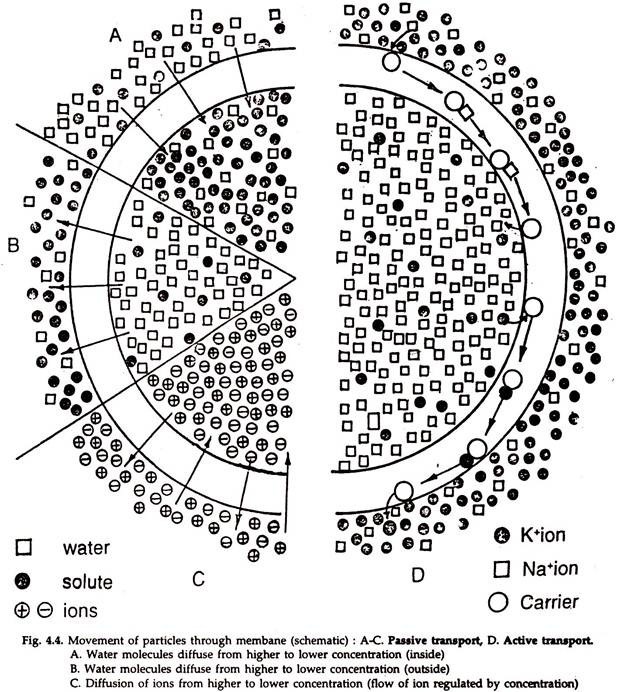In this article we will discuss about the passive and active transport of substances across plasma membrane.
All substances moving from outside to inside a cell, be it from external environment to epithelial cells of the body surface or from interstitial fluid to cell inside the body, must pass through the plasma membrane surrounding the cell.
The plasma membrane is provided with minute pores, the diameters of which determine the maximal size of the molecules allowed to pass through the membrane. The transport of substances from the surroundings to inside the cells and from the cells to the surroundings take place by two means.
Passive Transport:
In this type of transport no energy is required. Movement of molecules entirely depends on their relative sizes and concentrations on either side of the plasma membrane.
ADVERTISEMENTS:
The flow takes place from higher to lower concentration (Fig. 4.4A-C).
Movement of ions across the membrane follows the principle of passive transport. Particles with an electric charge will move to the particles having opposite charge, provided the flow is from higher to lower concentration.
Active Transport:
ADVERTISEMENTS:
Movement of molecules against concentration gradient is known as active transport Energy is required to move the molecules in a direction opposite to that which would have taken place in passive transport (higher to lower concentration) (Fig. 4.4D).
In active transport an important role is played by carrier molecules in the membrane. The carrier molecules combine with the molecules of the substance to be transported from outside, form temporary compound, carry those inside the cell and released there. Alternately, it may operate in the same way to carry molecules from inside to outside the cell.
Cell and Environment: Exchange of Materials:
An organism is intimately associated with its surroundings. Exchange of materials are constantly taking place between the cell and its surroundings. Exchange takes place between cells on the body surface and environment and also between the cells and its surroundings inside the body.
ADVERTISEMENTS:
The chemical factors in outside environment, oxygen and carbon dioxide concentration, acidity, alkalinity and temperature; in the internal environment, the concentrations of different substances, viz., carbohydrate, amino acid and other nutrients and carbon dioxide in the interstitial fluid greatly influence the activities of an organism.
In terrestrial forms, the chief requirements of organisms are received from the lumen of the gut (products of digestion) and lung alveoli (oxygen). In aquatic forms, in addition to those, substances from outside are taken in and given out from the body through the skin, gills, etc.
The plasma membrane, surrounding the cell, plays a vital role in the process of exchange of materials. All nutrients and waste products must pass through the plasma membrane to enter or leave the cell. The plasma membrane is surrounded by interstitial fluid.
Substances only in solution can pass through the membrane. The membrane bears ultramicroscopic pores. These pores determine the maximal size of the molecules that can pass through them. Electric charge, if any, the number of water molecule bonds to different molecules, and its solubility in fatty substances, largely govern the diffusion.
The membranes are of different types:
(a) Permeable, allows any substance to pass through it;
(b) Non-permeable, allows no substance to pass and
(c) Semipermeable or differently permeable, allows certain but not all substances to diffuse through it.
The plasma membrane, nuclear membrane and vacuoles are semipermeable.
